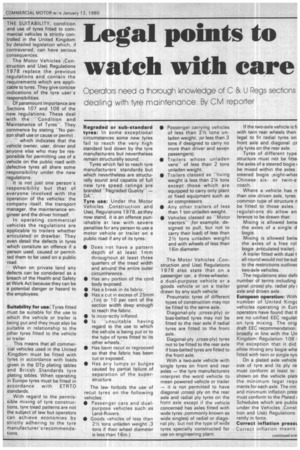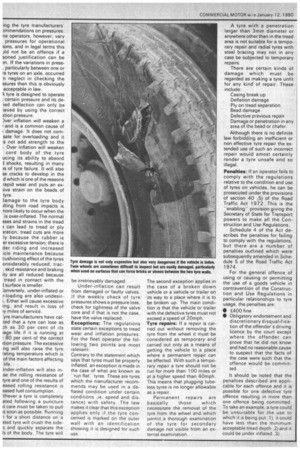Legal points to watch with care
Page 47

Page 48

If you've noticed an error in this article please click here to report it so we can fix it.
Regraded or sub-standard tyres: In some exceptional circumstances some new tyres fail to reach the very high standard laid down by the tyre manufacturers but nevertheless remain structurally sound.
Tyres which fail to reach tyre manufacturers' standards but which nevertheless are structurally sound and capable of full new tyre speed ratings are branded "Regraded Quality" — DA".
Tyre use: Under the Motor Vehicles :,Construction and Use), Regulations 1978, asthey now stand, it is an offence punishable at law with severe penalties for any person to use a motor vehicle or trailer on a public road if any of its tyres: • Does not have a pattern depth of at least 1mm throughout at least three quarters of the tread width and around the entire outer circumference.
• Has any portion of the cord body exposed.
• Has a break in its fabric.
• Has a cut in excess of 25mm k1 in) or 10 per cent of the section width deep enough to reach the fabric.
• Is incorrectly inflated.
• Is "unsuitable having regard to the use to which the vehicle is being put or to the type of tyres fitted to its other wheels.
• Has been recut or regrooved so that the fabric has been cut or exposed.
• Has any lumps or bulges caused by partial failure of separation of the superstructure.
The law forbids the use of recut tyres on the following vehicles: • Passenger cars and dualpurpose vehicles such as Land-Rovers.
• Goods vehicles of less than 21/2 tons unladen weight k3 tons if their wheel diameter is less than 16in.)
• Passenger carrying vehicles of less than 21/2 tons unladen weight, or less than 3 tons if designed to carry no more than driver and seven passengers).
• Trailers whose unladen vans" of less than 2 tons unladen weight.
0 Trailers classed as "living weight is less than 21/4 tons except those which are equipped to carry only plant or fixed equipment such as air compressors.
Any other trailers of less than 1 ton unladen weight. Vehicles classed as "Motor tractors" ,for example, designed to pull, but not to carry their load) of less than 21/2 tons unladen weight and with wheels of less than 16in diameter.
The Motor Vehicles kConstruction and Use) Regulations 1978 also state that on a passenger car, a three-wheeler, a dual-purpose vehicle or a goods vehicle or on a trailer drawn by any such vehicle: Pneumatic tyres of different types of construction may not be fitted to the same axle.
Diagonal-ply cross-ply) or bias-belted tyres may not be fitted to the rear axle if radial tyres are fitted to the front axle.
Diagonal-ply ,cross-ply) tyres not to be fitted to the rear axle if bias-belted tyres are fitted to the front axle.
With a two-axle vehicle with 'single tyres on front and rear axles — the tyre manufacturers interpret the word vehicle to mean powered vehicle or trailer — it is not permitted to have diagonal .,cross) ply on the rear axle and radial ply tyres on the front axle except if the vehicle concerned has axles fitted with wide tyres ,,commonly known as wide singles) of radial or diagonal ply, but not the type of wide tyres specially constructed for use on engineering plant.
If the two-axle vehicle is fi with twin Tear wheels then legal to fit radial tyres on front axle and diagonal kcr ply tyres on the rear axle.
Tyres of different type structure must not be fittei the axles of a steered bogie be mixed within the axles steered bogie eight-whec Chinese sixor twin-s• coach.
Where a vehicle has rr than one driven axle, tyres common type of structure n be fitted to those axles. regulations do allow an ference to be drawn that: Mixing is allowed betw the axles of a single d bogie.
Mixing is allowed betw the axles of a free rol bogie ,,articulated trailer). A trailer fitted with dual t all round would not be sut to the restrictions outlinec two-axle vehicles.
The regulations also defii number of terms including gonal !,cross) ply, radial ply axle and driven axle.
European operation: With number of United Kingc vehicles operating in Eurc operators have found that tl are no unified EEC regulat on tyre mixing. The orig draft EEC recommendation broadly in line with the Un Kingdom Regulation 108 the exception that it did allow mixing any bogie whe fitted with twin or single tyrt
On a plated axle vehicle size .of tyre and its ply ra. must conform at least to shown on the vehicle platc the minimum legal requ ments for each axle. The rim and minimum inflation pres must conform to the Plated Schedules which are publis under the Vehicles kConst tion and Use) Regulations rently in force.
Correct inflation presst. Correct inflation means
.ing the tyre manufacturers' Dmmendations on pressures. ne operators, however, vary pressures for operational tons, and in legal terms this Jld not be an offence if a soned justification can be an. If the variations in press, particularly between one or re tyres on an axle, occurred n neglect in checking the ssures then this is obviously acceptable in law.
\ tyre is designed to operate ! certain pressure and its deled deflection can only be ieved by using the correct 3tion pressure.
)ver inflation will weaken a and is a common cause of damage. It does not cornsate for overloading and it !s not add strength to the Over inflation will weaken cord body of the tyre ucing its ability to absord shocks, resulting in many as of tyre failure. It will also se cracks to develop in the d which is one of the reasons rapid wear and puts an ex;lye strain on the beads of tyre.
)amage to the tyre body ilting from road impacts is nore likely to occur when the is over-inflated. The normal sses and strains in the tread 3 can lead to tread or ply 3ration; tread cuts are more ly because the rubber is er excessive tension: there is der riding and increased icle maintenance because cushioning effect of the tyres onsiderably reduced; trac, skid resistance and braking ity are all reduced because tread in contact with the isurface is smaller. :onversely, under-inflated or r-loading are also undesir-, Either will cause excessive ing, and result in loss of iy miles of service.
ryre Manufacturers have calted that a tyre can lose as as 30 per cent of its age life if it is running at 80 per cent of the correct ition pressure. The excessive ng will also raise the tyre rating temperature which is of the main factors affecting life.
inderinflation will also inse the rolling resistance of tyre and one of the results of eased rolling resistance is eased fuel consumption. Vhever a tyre is completely ated following a puncture it care must be taken to pull is soon as possible. Running for a short distance on a ated tyre will crush the sides and quickly separate the Is ot the body. The tyre will be irretrievably damaged.
Under-inflation can result from damaged or faulty valves. If the weekly check of tyre pressures shows a pressure loss, check for tightness of the valve core and if that is not the case, have the valve replaced.
Exceptions: The regulations state certain exceptions to tread wear and inflation pressures. For the fleet operator the following two points are most relevant:
Contrary to the statement which says that tyres must be properly inflated, an exception is made in the case of what are known as 'run flat'. tyres. These are tyres which the manufacturer recommends may be used in a deflated condition under certain conditions ,ie, speed and distance) with safety. The law makes it clear that this exception applies only if the tyre concerned is marked on the outer wall with an identification showing it is designed for such use.
The second exception applies in the case of a broken down vehicle or a vehicle or trailer on its way to a place where it is to be broken up. The main condition is that the vehicle or trailer with the defective tyres must not exceed a speed of 20mph.
Tyre repairs: If a repair is carried out without removing the tyre from the wheel it must be considered as temporary and carried out only as a means of getting the vehicle to a place where a permanent repair can be effected. With such a temporary repair a tyre should not be run for more than 100 miles or at a higher speed than 40mph. This means that plugging tubeless tyres is no longer allowable as a repair.
Permanent repairs are
basically those which necessitate the removal of the tyre from the wheel and which permit a thorough examination of the tyre for secondary damage not visible from an external examination.
A tyre with a penetration larger than 3mm diameter or anywhere other than in the tread area is not suitable for a temporary repair and radial tyres with steel bracing may not in any case be subjected to temporary repairs.
There are certain kinds of damage which must be regarded as making a tyre unfit for any kind of repair. These include: Casing break up Deflation damage Ply on tread separation Bead damage Defective previous repair Damage or penetration in any area of the bead or chafer.
Although there is no definite law forbidding an inefficient or non effective tyre repair the extended use of such an incorrect repair would amost certainly render a tyre unsafe and so illegal.
Penalties: If an operator fails to comply with the regulations relative to the condition and use of tyres on vehicles, he can be prosecuted under the provisions of section 40 i,5) of the Road Traffic Act 1972. This is the "enabling" provision giving the Secretary of State for Transport powers to make all the Construction and Use Regulations.
Schedule 4 of the Act describes the penalties for failing to comply with the regulations, but there are a number of penalties outlined which were subsequently amended in Schedule 5 of the Road Traffic Act 1974.
For the general offence of using or causing or permitting the use of a goods vehicle in contravention of the Construction and Use Regulations in particular relationships to tyre usage, the penalties are: • £400 fine • Obligatory endorsement and discretionary disqualification of the offender's driving licence by the court except where the offender can prove that he did not know and had no reasonable cause to suspect that the facts of the case were such that the offence would be committed.
It should be noted that the penalties described are applicable for each offence and it is possible for one defective tyre offence resulting in more than one offence being committed. To take an example, a tyre could be unsuitable for the use to which it is being put ,1), it could have less than the minimum acceptable tread depth ,2) and it could be under inflated ,3).












































































































